This article has been reviewed according to Science X's editorial process and policies. Editors have highlighted the following attributes while ensuring the content's credibility:
fact-checked
trusted source
proofread
3D scans will uncover the secrets of Iron Age gold treasure
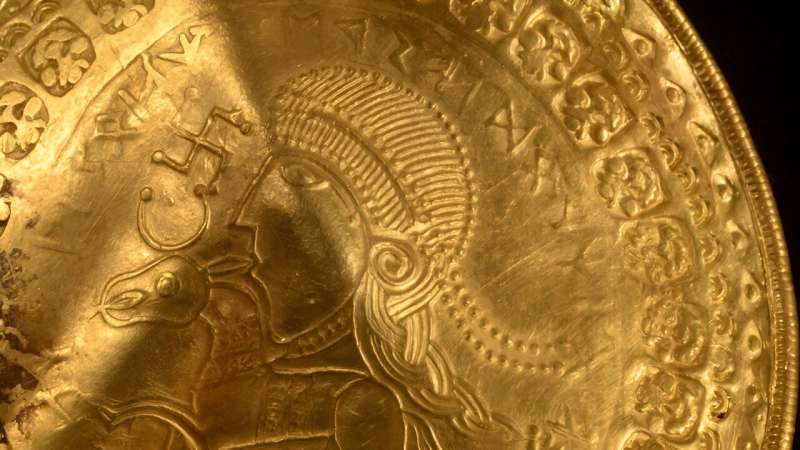
Photographers and journalists from the BBC, TV 2, and DR were ready when an armored car drove up to the front of DTU's 3D Imaging Center on 10 February 2022. All cameras were pointed directly at a brown shoebox, which an archaeologist from the Danish National Museum carefully took out of the armored car and carried through the revolving door to the 3D Imaging Center.
Inside the shoebox was the world's largest gold bracteate. The bracteate, which is a medallion-like necklace measuring 13.5cm, was found along with 15 other bracteates and four Roman medallions by an amateur archaeologist the year before in a field near the town of Vindelev in Denmark. Weighing 794 grams combined, the gold treasure is estimated to have been buried in the 6th century, and experts have compared the discovery to that of the Golden Horns of Gallehus.
The problem, however, is that many of the bracteates are folded to a point where the archaeologists are unable to see the motifs and runic inscriptions on them. It is too risky to unfold the gold by hand, as it may break, which is why the National Museum and the Vejle Museums have sought the help of modern technology at DTU.
"Sometimes technology can open doors that we can't. In this case, we want to get a better look at the inscriptions and images on the bracteates so we can learn more about the nobleman who owned the treasure. What was his position? What was his domain? If we succeed, we will gain a better understanding of the structure of society in the 5th and 6th century," says Mads Ravn, archaeologist and Head of Research at the Vejle Museums.
The technology Ravn is hoping can provide new answers is known as CT scanning in hospitals, where it is used to create detailed X-ray images of a patient's internal organs. In recent times, this technology has also been used by physicists to scan material objects and recreate them as digital 3D models. For example, DTU has used it to scan and reconstruct a 66-million-year-old T. rex skull.
However, the bracteates from the National Museum were not only brought to DTU's 3D Imaging Center in February 2022 to be scanned and reconstructed—they also needed to be digitally unfolded. After completing the scan, DTU's researchers were thus left with an ancient mystery and 9,600 CT images to unfold it.
Gold thickness causes problems
One of the challenges in solving the mystery was the varying thickness of the gold. Where the gold on the bracteates is thin due to stamp pressure and engravings, the scans have produced what is called CT artifacts, which are visual discrepancies between the real bracteate and the resulting CT image.
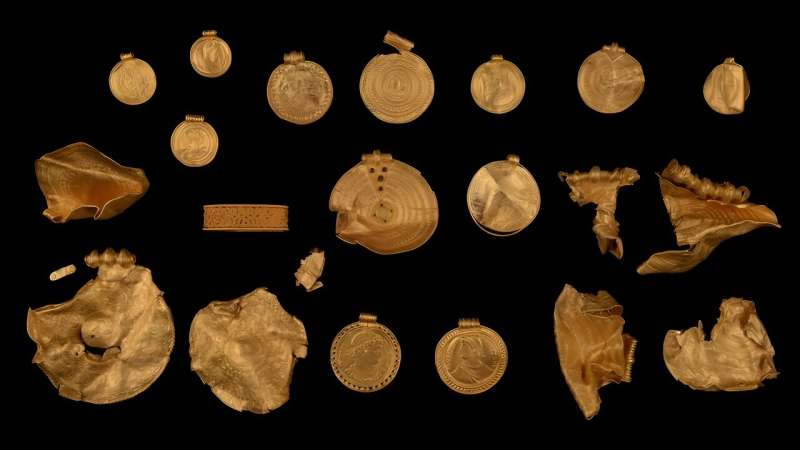
"In hospitals, artifacts occur when, for example, you're performing a CT scan on a patient with surgical screws in their leg. The screws will create lines in the image, and the same thing has happened in this project. Our images are full of lines that wouldn't be there if the bracteates had had the same thickness everywhere," explains Carsten Gundlach, Senior Executive Research Officer at DTU Physics.
He used the data from the hundreds of 360-degree scans of each bracteate for calculations for the spatial 3D images. Gundlach says that this method has resulted in fairly accurate 3D reconstructions of the bracteates in their folded condition. Nevertheless, the artifacts still caused trouble for Gundlach's DTU Compute colleague, Hans Martin Kjer, who tried to digitally unfold the bracteates.
"We've tried to unfold one of the smaller bracteates called X17, but it's difficult for us to define the edge of the bracteate and the exact line between two surfaces. When the gold has many tight folds, it makes it difficult for us to separate the surfaces from each other. Ultimately, it makes it very difficult to produce a perfect unfolding where you can see all the details," says Kjer.
However, the two researchers refused to give up. Through conversations with the archaeologists, they have gained an idea of which motifs are of special interest in a historical context. The focus of the project has therefore shifted from unfolding the entire bracteate to unfolding the individual parts that can give archaeologists new knowledge about Denmark in the 5th and 6th century.
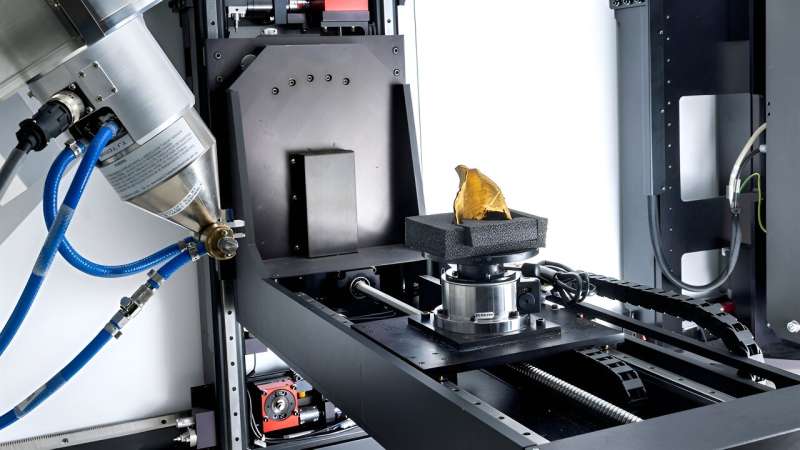
Treasure may have changed owners
Ravn says that Denmark at the time of bracteates can best be described as what the Romans called "wild Germania." Here, autocratic clan leaders ruled marked territories according to the same rules now used by biker gangs or the Mafia.
"The more wars they won, the stronger clan leaders they became. And the more gold and riches they could get for their followers, the more followers they got," says Ravn.
Judging by the size of the treasure from Vindelev, he believes that its owner must have been a very powerful, but previously unknown, clan leader. This gives the site around Vindelev, located 8km east of Jelling, the cradle of Denmark, a new and significant status as a center of power.
At the same time, the treasure from Vindelev bears a close resemblance to other gold treasures found near the town of Gudme on Funen, which is considered to have been Denmark's most important center of power from the 3rd to the 6th century. This leads archaeologists to believe that some of the bracteates from Vindelev may have been made by a blacksmith in Gudme. If that is the case, the gold must have changed owners at some point.
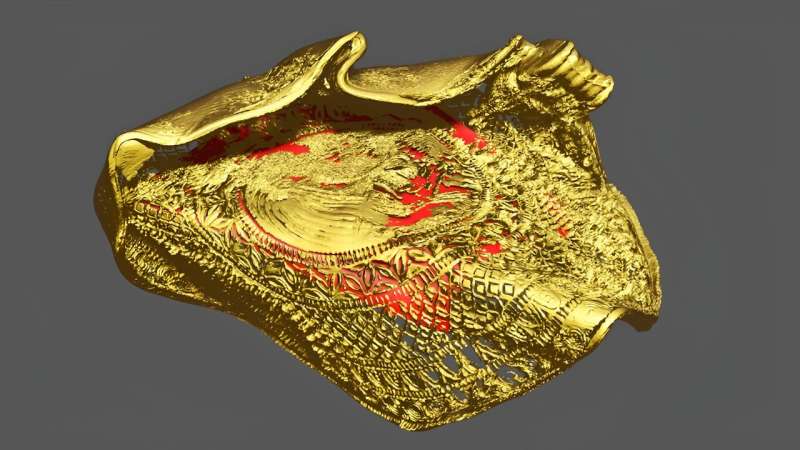
The theory is therefore that there was a close connection—perhaps an alliance—between the clan leaders of the two centers of power. "It's possible that the gold was handed over as a gift in connection with weddings between daughters and sons from each clan," says Ravn.
In order to confirm this theory, Ravn is particularly interested in seeing the motifs on the largest of the gold bracteates, which seems to have a folded twin motif in the middle. The stamps around the motif can also tell the researchers something about the origin of the bracteate and how old it is. If they turn out to bear the same stamps as the ones found in Gudme, then they were made by the same goldsmith, and the archaeologists can continue working with the theory of the close connection between Vindelev and Gudme.
"It's a bit like a court case where the more circumstantial evidence we find, the stronger the case will be. We can't exactly ask the witnesses who were there at the time. We rely on circumstantial evidence, and this is where DTU can help," explains Ravn.
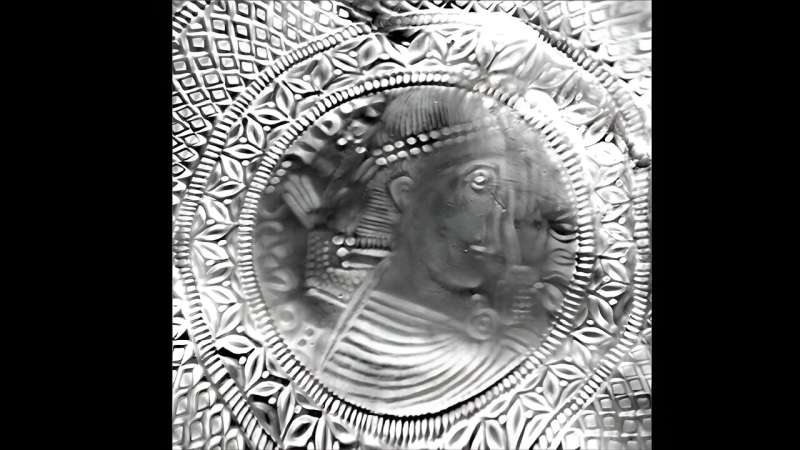
Research never ends
In the digital treasure hunt for answers, DTU's researchers have come closer to finding the evidence than before. They have succeeded in unfolding a small area with fewer folds on one of the smaller bracteates called X19.
"It's a significantly better result than when we tried unfolding the entire bracteate. With this method, we can optimize the individual areas," says Gundlach. However, while he still believes that the results can be improved, he thinks that the method has potential worth pursuing.
"The method opens up the possibility of piecing together the individual parts after they've been unfolded," he says.
The Vejle Museums are very enthusiastic about the new results, not just because the method can provide new insight into the power dynasties of the Iron Age, but also because it may help archaeologists determine why some of the bracteates appear to have been folded by hand while others have probably been destroyed by a modern plow centuries after being buried.
"It would be interesting to see if DTU can distinguish between the randomly destroyed bracteates and the deliberately folded ones using the mathematical algorithms that they're already working with. We expect that the deliberately destroyed bracteates will be more symmetrically folded," says Ravn. He explains that if the clan leader himself has folded the bracteates, it indicates that the treasure was used as a sacrifice to the gods.
The next step is to unfold the twin motif and the stamps on the world's largest bracteate. The DTU researchers are hoping that the work with the treasure will open up a new string of collaborations with archaeologists and museum professionals. But when the goal has been reached and the researchers will be satisfied remains just as unanswered as many of the riddles that still surround the treasure from Vindelev.
"There are still many challenges to solve. Of course it's annoying that you can't just finish things up and move on. But you can always do more," says Kjer and adds, "Research never ends."
Provided by Technical University of Denmark



















